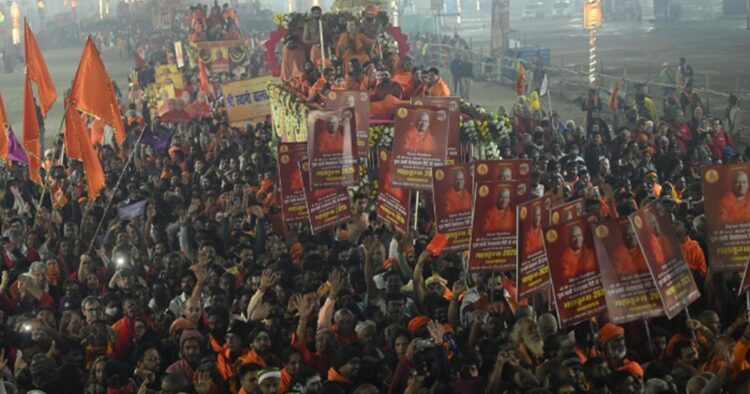Approximately, crores of devotees from all over the world seeking moksha (spiritual emancipation) with the sacred dip, the Mahakumbh celebrated its third “Amrit Snan,” on Sunday on the auspicious occasion of Basant Panchami. Additionally, Amrit Snan is the grandest and most sacred ritual of the Mahakumbh Mela. Saints and sages, including Naga sadhus from different akharas, started their ceremonial march towards the Triveni Sangam (confluence of Yamuna, Ganga and Saraswati rivers) at the crack of dawn. The Naga sadhus attracted attraction at the Mahakumbh because of their unique rituals.
The Mahanirvani and Atal Akharas finished their rituals by 5:40 am, rather than 6:15 am as they did on Makar Sankranti on 14th January, amid mounted police personnel closely monitoring Sangam Nose. At 4 am they left their camps for the bathing ghats at 4 am. Sadhus of akharas were required to finish their rites by 3:55 pm following arriving at the bathing ghats in processions. Once they departed, regular devotees were permitted to take a dip at Sangam Ghats. The third “Amrit Snan” featured captivating processions led by “Mahamandleshwars” (chiefs) of several akharas.
The mela authorities worked with the senior sadhus of the akharas to find out a bathing timetable in order to guarantee a mishap-free event. Every akhara had a forty-minute window to visit the holy waters, and by 8.30 am, the first procession had finished their rite and headed back to their camps. The akharas and the Uttar Pradesh government advised people not to prioritize reaching the main confluence point, saying that all ghats carry equal importance, following the stampede at the Sangam Nose, which many perceive to have higher spiritual significance.
According to tradition, the three akharas belonging to Sanyasi, Bairagi and Udaseen sects took the sacred dip in a specific order. According to the timetable made public by the Kumbh Mela officials, the Sanyasi sect’s akharas kicked off the “Amrit Snan,” formerly known as the “Shahi Snan,” at 4 am. Panchayati Akhara Mahanirvani, Shambhu Panchayati Atal Akhara, Taponidhi Panchayati Sri Niranjani Akhara, Sri Panchayati Akhara Anand, Panchdashnam Juna Akhara, Panchdashnam Avahan Akhara and Panchagni Akhara led the revered procession.
The first procession concluded the ritual and headed back to their camps within the 40-minute window that each akhara has been allotted to visit the divine waters. The Bairagi sect’s akharas, whose bathing ritual started at 8:25 am, were next in line. All India Shri Panch Nirvani Ani Akhara, All India Shri Panch Digamber Ani Akhara, and All India Shri Panch Nirmohi Ani Akhara were among the procession. Each group’s turn ended at 12:35 pm and then the last group entered the holy waters.

















Comments